Papers by Florian Wiencek

Rezensiv - Online-Rezensionen und Kulturelle Bildung, 2021
Als Theoretiker und Praktiker an der Schnittstelle von Digitalen Medien und Kunstvermittlung möch... more Als Theoretiker und Praktiker an der Schnittstelle von Digitalen Medien und Kunstvermittlung möchte ich, die Ergebnisse aus der Bildungswissenschaft einbeziehend, insbesondere auf die potenzielle Rolle von Rezensionen als mediale Form der Kunstvermittlung eingehen. Hervorzuheben sind hier aus meiner Sicht drei Aspekte: a) die Rezension als Linse für die Kunstwahrnehmung; b) die Rezension als Tool für co-kreative Wissensgenerierung; und c) die Rezension als Vernetzungs-Hub. Mein Ausgangspunkt im Hinblick auf Kunstvermittlung ist die kritische Kunstvermittlung von Carmen Mörsch (2011), bei der nicht die Reproduktion von Wissen oder das »Grand Narrative« einer Institution im Vordergrund steht, sondern die Wissensgenerierung zusammen mit den Besucher_innen. Es geht also um die Förderung der aktiven Auseinandersetzung mit Kunstwerken oder Ausstellungen wie beispielsweise das eigene Nachdenken und die eigene Interpretation. Gerade im Licht dieses Verständnisses von Vermittlung kann die Rezension als mediale Form ihre Stärken ausspielen, geht es doch um eine bewusste Wahrnehmung von Kunst durch die Besu-cher_innen. Wie die Rez@Kultur-Forschungsergebnisse zeigen, können der Akt des Rezensierens sowie die vorausgehende Antizipation dieser Aufgabe als Vehikel zur aktiven Auseinandersetzung mit Kunst dienen und zu einer bewussteren und intensivierten Wahrnehmung sowie zur Ref lexion der eigenen Wahrnehmung führen. Zudem fördert gerade die Rolle der Kriti-ker_in das Bilden einer eigenen Meinung und einer eigenen Interpretation. Das eigene subjektive Erleben und Nachdenken ist hierbei Ausgangspunkt für die Schaffung eines neuen Ausdrucks, eines kreativen Produkts.
Museen der Zukunft, 2021
Kasra Seirafi und Florian Wiencek stellen in ihrem Beitrag drei digitale Outreach-Aspekte vor, mi... more Kasra Seirafi und Florian Wiencek stellen in ihrem Beitrag drei digitale Outreach-Aspekte vor, mit denen Museen ihre Vermittlung und Reichweite erhöhen, digital öffnen und sich mit ihrer Umgebung verbinden können: digitale Karten, Augmented Reality und Gamification. Anhand von Beispielen aus der digitalen Vermittlungspraxis zeigen sie auf, wie das Museum institutionell, örtlich und zielgruppen-spezifisch erweitert und geöffnet werden kann. Hierbei wird digitaler Outreach als essentieller Baustein innovationsorientierter Kulturarbeit positioniert, um das erweiterte und offene Museum der Zukunft zu ermöglichen.
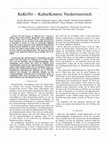
Not least because of “Pokemon Go”, everyone is talking about context-sensitive applications. Thes... more Not least because of “Pokemon Go”, everyone is talking about context-sensitive applications. These applications are also widely used in tourism and in cultural institutions, whose collections can not be shown to the public physically due to renovation or because of a lack of a permanent exhibition house. We use these experiences in the application KulturKontext Niederösterreich (KuKoNö) in order to make it possible to get to know and explore cultural objects from the State Collection of Lower Austria in the physical space. This paper presents the concept of the application KuKoNö and an example tour for St. Pölten. Zusammenfassung—Kontextsensitive Anwendungen sind nicht zuletzt nach dem Erfolg von “Pokemon Go” in aller Munde. Aber auch im Tourismus und in Kultureinrichtungen, deren Sammlungen durch Umbau oder durch ein fehlendes festes Ausstellungshaus physisch nur eingeschränkt der Öffentlichkeit gezeigt werden können, finden diese Anwendungen starke Verbreitung. Diese Erfahrungswe...
Providing accessible ways to our cultural heritage is a key responsibility for modern societies. ... more Providing accessible ways to our cultural heritage is a key responsibility for modern societies. This paper outlines ideas for using new Augmented and Virtual Reality technologies at museums. First, we will give a short introduction on the latest developments of AR/VR technology and their inherent potentials for museums. Secondly, the ongoing R&D project “HoloMuse” will be introduced which aims at developing new forms of Augmented Learning for cultural heritage venues. HoloMuse is a collaborative effort of technology partners, academic institutions, and worldwide renowned museums to make the next steps towards real innovative and meaningful museum visitor experiences based on AR/VR technologies and cutting-edge learning theories. We will outline several deployment scenarios of AR/VR in museums giving a prospective on the future of cultural learning.

This PhD thesis analyzes digital and data-based practices of mediation of art and culture, focusi... more This PhD thesis analyzes digital and data-based practices of mediation of art and culture, focusing on digital cultural repositories and databases as central mediation tools. It embeds the digital mediation practices discussed in this thesis in the media-theoretical and media-historic context of the transformation processes that have taken place in the digital media ecology, which have resulted in challenges for cultural institutions and museums, both in their role as institutions as well as in their daily mediation work. The thesis also situates digital mediation practices in the context of contemporary, analog practices of cultural learning, since the analog and digital realms can no longer be separated in the contemporary media ecology. One central topic of the analysis is mapping and understanding practices of mediation of art and culture and cultural learning in the digital realm. This is based on the database as a cultural form and repository that defines what can be said and ...

Studies in Media and Communications, 2012
Purpose – This chapter analyzes the visual coverage of amok school shootings with the aim of trac... more Purpose – This chapter analyzes the visual coverage of amok school shootings with the aim of tracing particular patterns of visualization relating to the representation of victimizers and victims. Methodology – Based on a qualitative mixed-method design combining visual content with visual context analysis of print and online coverage of the incidents, a tentative typology is developed to be tested in future empirical studies. The exploratory study builds on empirical data derived both from print and online coverage of two amok rampage incidents in Germany (Winnenden/Wendlingen, March 2009; Ansbach, September 2009). For comparative reasons the online visual coverage of three amok school shootings in the United States (Littleton, 1999; Red Lake, 2005; Blacksburg, 2007), two in Finland (Tuusula, 2007; Kauhajoki, 2008), as well as two additional cases in Germany (Erfurt, 2002; Emsdetten, 2006) were included in the sample. Findings – A typology of mainly press photographs about amok school shootings with three main categories – visuals portraying the perpetrator(s), visuals portraying the victims, and visuals about the context. For each of the three main categories there are several subcategories. However, quality media focus on context visuals while tabloid media focus on the perpetrator, and sometimes on the victims. Additionally, a clear distinction between print and online media emerged, with quality print media adhering more strictly to privacy laws than both tabloid and quality online sites. Research limitations – Different samples of amok events; only one with a full sampling of both print and online newspapers and magazines; TV coverage not taken into account. Practical implications – Heightened media attention and the pervasive need of media to visualize violent events underscore the relevance of empirically based guidelines for photojournalists and editors alike. The results of this study are a first step in this direction. Originality – The chapter contributes to visual communication research insofar as it presents a first theoretical and methodological approach to operationalize visuals in the context of reporting about a particular type of violent event.
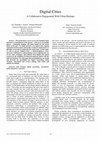
2013 Digital Heritage International Congress (DigitalHeritage), 2013
The urban body is never at rest, the changing needs and desires of inhabitants in the presentwith... more The urban body is never at rest, the changing needs and desires of inhabitants in the presentwith an eye to possible futurescontinually shaping, and being shaped by, the urban fabric of the past. No single narrative can capture this ongoing negotiation between place and people; it must be understood as a plurality of narratives bound into the urban body. In this paper we will we present 'Digital Cities', a multidisciplinary , crossuniversity collaborative undergraduate course exploring the use of new tools, techniques and methods from digital and spatial research in the mediation of historical material culture and the built environment. We will argue that such platforms can enrich and diversify the possibilities for digital storytelling within scholarly, educational and creative settings, both within and outside of academia.
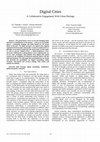
Proceedings of the 2013 Digital Heritage International Congress (Vol. 2), 2013
The urban body is never at rest, the changing needs and desires of inhabitants in the presentwith... more The urban body is never at rest, the changing needs and desires of inhabitants in the presentwith an eye to possible futurescontinually shaping, and being shaped by, the urban fabric of the past. No single narrative can capture this ongoing negotiation between place and people; it must be understood as a plurality of narratives bound into the urban body. In this paper we will we present 'Digital Cities', a multi-disciplinary, crossuniversity collaborative undergraduate course exploring the use of new tools, techniques and methods from digital and spatial research in the mediation of historical material culture and the built environment. We will argue that such platforms can enrich and diversify the possibilities for digital storytelling within scholarly, educational and creative settings, both within and outside of academia.
Proceedings of the ISEA 2011
Proceedings of the ISEA 2011 conference
Online Publications by Florian Wiencek

The Network Ecologies digital Scalar publication is the culmination of a five-year, multi-format,... more The Network Ecologies digital Scalar publication is the culmination of a five-year, multi-format, interdisciplinary venture to curate a dynamic scholarly digital publication. It has been, for us, a collaborative creative-critical interrogation into the theoretical and scholarly implications of the digital on rigorous scholarly publication. Amanda Starling Gould and Florian Wiencek set out to create a 'networked publication' and we believe we've done just that. We have content ranging from text-based essays to a visual art 3D scanning documentary project that was created specifically for our publication. You'll find transmedia essays on art, technics, data visualization, book-making, theory, mentorship, architecture, network engineering, gaming, and capitalism. You'll find tweets, videos, text, and tools. You’ll even find a garden gnome or two lurking throughout.
The goal of this project was for each of us to bring our own research—developed and delivered in our own unique disciplinary vernaculars—together to converge around a shared concept. The assumption is that through transdisiplinary co-mingling and collaboration, both our individual research projects and the Network Ecologies publication, as a living research hub, can gain new dimension. We hope that by putting diverse minds in dialogue with each other, we can facilitate a more robust understanding of the network by way of merging and (re)mixing multidisciplinary understandings.
We encourage you to start with the short Introduction to learn more about the full shape of the project and about navigating the publication and interacting (using Hypothes.is) with the content and with each other.
or-bits.com, May 18, 2012
Book Chapters by Florian Wiencek
Andrea Geipel, Johannes Sauter, Georg Hohmann (Eds.): Das Digitale Objekt – Zwischen Depot und Internet. München : Deutsches Museum Verlag, 2020
Die Deutsche Nationalbibliothek verzeichnet diese Publikation in der Deutschen Nationalbibliograf... more Die Deutsche Nationalbibliothek verzeichnet diese Publikation in der Deutschen Nationalbibliografie; detaillierte bibliografische Daten sind im Internet unter http://dnb.de abrufbar. Diese Veröffentlichung -ausgenommen Zitate und Abbildungen -ist lizenziert unter Creative Commons CC BY-SA 3.0 DE. Siehe Abbildungsverzeichnis für Bildnachweise.
Majora, C.; Menezes, C. & Poltronieri, F. A. (Eds.). "The Permanence of the Transient. Precariousness in Art", 2014
Glenn W. Muschert and Johanna Sumiala (Eds.). School Shootings: Mediatized Violence in a Global Age, 2012

Rotert, A. Nöring, H. & Sausmikat, R. Katalog des European Media Art Festival Osnabrück 2009, 2009
Wir leben heute nicht mehr nur im Zeitalter der technischen Reproduzierbarkeit des Kunstwerks, da... more Wir leben heute nicht mehr nur im Zeitalter der technischen Reproduzierbarkeit des Kunstwerks, das die Aura des Originals in Frage stellt, sondern auch im Zeitalter der universalen Informatisierbarkeit aller Daten, das Körperlichkeit und Materialität in Frage stellt. Was uns zu entschwinden droht, ist alles, was nicht in den ebenso rasanten wie homogenen Datenstrom eingespeist werden kann. Mit der Materialität von Artefakten verschwindet aber weit mehr als nur eine geheimnisvolle Aura; mit ihr verschwinden Realität, Geschichte und Gedächtnis." 1 , schreibt Aleida Assmann. Dies betrifft paradoxer Weise auch die Kunstformen, die wie die digitalen Daten ebenfalls immateriell und flüchtig sind: beispielsweise zeitbasierte, prozessorientierte und mit Installationen sich auch in den Raum erstreckende Kunstformen. Unbestritten ist die Tatsache, dass gerade ephemere Arbeiten, die auf digitaler Technik basieren, beispielsweise interaktive Arbeiten in diversen Ausprägungsformen, für ihre Bewahrung auf Dokumentation und die Archivierung derselben angewiesen sind. 2 Dieter Daniels beschreibt ein Vermittlungsparadox der elektronischen Medienkunst 3 , bei dem er davon ausgeht, dass die künstlerische Arbeit zwar in elektronischen Medien stattfindet, sie aber in ihrer Vermittlung nur wenig von diesem Verbreitungspotential profitieren kann. Denn ein solches Projekt ließe sich in der klassischen Text-Bild-Darstellung, wie sie beispielsweise in Katalogen zur Anwendung kommt, nur unzureichend vermitteln, da die Erfahrung der medialen Qualitäten unabdingbar für das Erfassen der Arbeiten sei. Insofern müssten solche Projekte multimedial vermittelt und zudem mit relevanter Theorie in Beziehung gesetzt werden. Eine weitere Schwierigkeit im Umgang mit medialen Kunstwerken -gerade für Forschung und Lehre -ist nach Daniels der Zugang. Bei der Vermittlung von Medienkunst geht es also zunächst einmal darum, die Arbeiten in irgendeiner Form für die Öffentlichkeit verfügbar zu machen, was sowohl durch eine Präsentation der Arbeit als auch durch Dokumentation und Kontextualisierung erfolgen kann. Gerade bei interaktiver Kunst bzw. bei installativen Arbeiten besteht die Hauptaufgabe darin, die Erfahrung im Möglichkeitsraum der Arbeit, innerhalb ihres Regelwerks den Prozess und die Zeitlichkeit zugänglich und nachvollziehbar zu machen. Bei der Vermittlung der Erfahrung kann der Ausgangspunkt immer nur eine subjektive Erfahrung, eine Annäherung, eine Momentaufnahme sein.
Conference Presentations by Florian Wiencek
“Traversing Networks of Complexity. From Database Artworks to Contemporary Networked Publications... more “Traversing Networks of Complexity. From Database Artworks to Contemporary Networked Publications” co-written with Florian Wiencek, to be presented at the “Digital Abstraction at the Interface between Electronic Media Arts and Data Visualization,” Jacobs University, Bremen, Germany, May 7-8, 2015.
Books by Florian Wiencek
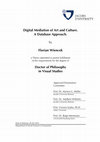
This PhD thesis analyzes digital and data-based practices of mediation of art and culture, focusi... more This PhD thesis analyzes digital and data-based practices of mediation of art and culture, focusing on digital cultural repositories and databases as central mediation tools. It embeds the digital mediation practices discussed in this thesis in the media-theoretical and media-historic context of the transformation processes that have taken place in the digital media ecology, which have resulted in challenges for cultural institutions and museums, both in their role as institutions as well as in their daily mediation work. The thesis also situates digital mediation practices in the context of contemporary, analog practices of cultural learning, since the analog and digital realms can no longer be separated in the contemporary media ecology.
One central topic of the analysis is mapping and understanding practices of mediation of art and culture and cultural learning in the digital realm. This is based on the database as a cultural form and repository that defines what can be said and known about a culture or society. The analysis introduces digital and data-based meaning-making processes within databases and database-interfaces themselves as well as cultural learning processes that reuse and contextualize the data in learning resources or by forming new experiences with them. The analysis concentrates mainly on web-based approaches and treats the process of co-creative knowledge generation as a central mode of the mediation of art and culture, using the paradigm of Software Studies developed by Lev Manovich as a lens for analysis.
Moreover, the thesis examines what characteristics of contemporary digital media and the digital media ecology are reflected or play an important role in digital, data-based mediation practices. It raises the question as to whether the employment of digital data leads to a changed notion of what mediation of art and culture can accomplish and highlights central directions for museums to react to and take advantage of ongoing digitization.



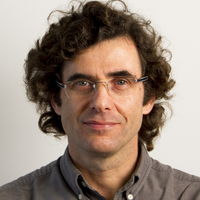





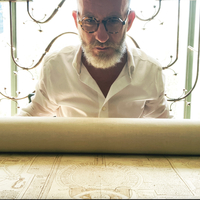

Uploads
Papers by Florian Wiencek
Online Publications by Florian Wiencek
The goal of this project was for each of us to bring our own research—developed and delivered in our own unique disciplinary vernaculars—together to converge around a shared concept. The assumption is that through transdisiplinary co-mingling and collaboration, both our individual research projects and the Network Ecologies publication, as a living research hub, can gain new dimension. We hope that by putting diverse minds in dialogue with each other, we can facilitate a more robust understanding of the network by way of merging and (re)mixing multidisciplinary understandings.
We encourage you to start with the short Introduction to learn more about the full shape of the project and about navigating the publication and interacting (using Hypothes.is) with the content and with each other.
Book Chapters by Florian Wiencek
Conference Presentations by Florian Wiencek
Books by Florian Wiencek
One central topic of the analysis is mapping and understanding practices of mediation of art and culture and cultural learning in the digital realm. This is based on the database as a cultural form and repository that defines what can be said and known about a culture or society. The analysis introduces digital and data-based meaning-making processes within databases and database-interfaces themselves as well as cultural learning processes that reuse and contextualize the data in learning resources or by forming new experiences with them. The analysis concentrates mainly on web-based approaches and treats the process of co-creative knowledge generation as a central mode of the mediation of art and culture, using the paradigm of Software Studies developed by Lev Manovich as a lens for analysis.
Moreover, the thesis examines what characteristics of contemporary digital media and the digital media ecology are reflected or play an important role in digital, data-based mediation practices. It raises the question as to whether the employment of digital data leads to a changed notion of what mediation of art and culture can accomplish and highlights central directions for museums to react to and take advantage of ongoing digitization.
The goal of this project was for each of us to bring our own research—developed and delivered in our own unique disciplinary vernaculars—together to converge around a shared concept. The assumption is that through transdisiplinary co-mingling and collaboration, both our individual research projects and the Network Ecologies publication, as a living research hub, can gain new dimension. We hope that by putting diverse minds in dialogue with each other, we can facilitate a more robust understanding of the network by way of merging and (re)mixing multidisciplinary understandings.
We encourage you to start with the short Introduction to learn more about the full shape of the project and about navigating the publication and interacting (using Hypothes.is) with the content and with each other.
One central topic of the analysis is mapping and understanding practices of mediation of art and culture and cultural learning in the digital realm. This is based on the database as a cultural form and repository that defines what can be said and known about a culture or society. The analysis introduces digital and data-based meaning-making processes within databases and database-interfaces themselves as well as cultural learning processes that reuse and contextualize the data in learning resources or by forming new experiences with them. The analysis concentrates mainly on web-based approaches and treats the process of co-creative knowledge generation as a central mode of the mediation of art and culture, using the paradigm of Software Studies developed by Lev Manovich as a lens for analysis.
Moreover, the thesis examines what characteristics of contemporary digital media and the digital media ecology are reflected or play an important role in digital, data-based mediation practices. It raises the question as to whether the employment of digital data leads to a changed notion of what mediation of art and culture can accomplish and highlights central directions for museums to react to and take advantage of ongoing digitization.